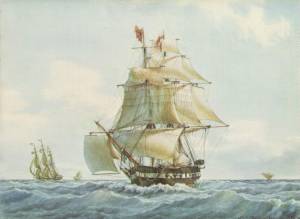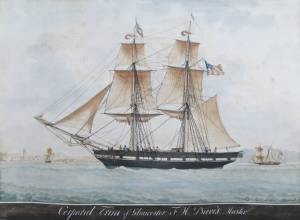An online project under the direction of the CAPE ANN MUSEUM
Roux, Ange-Joseph Antoine
View related Fitz Henry Lane catalog entries (1) »
Born to a family of hydrographers established in Marseilles since the late 1600s, Ange-Joseph Antoine Roux was the third generation to pursue the business of publishing, manufacturing, and selling charts and navigating instruments in the French port of Marseille. His father, Joseph Roux, was – from surviving examples – a competent portrayer (in oils) of ships, only a few of which are to be found in American collections.
Unlike his father, Ange-Joseph (or Antoine Roux, as we call him today) worked only in watercolors, developing a style marked by precise proportions and details in vessels set in seas with sharp, formulaic wave patterns which became softer and more realistic in later years.
Many of Antoine’s early (late eighteenth-century) works were ex voto pictures of vessels which were lost in battle or in storms. Given to churches as offerings of gratitude and devotion for the donor’s survival, many still hang in Catholic sanctuaries at Marseilles and other French ports, as is the case with other artists’ works in other European ports.
By the early 1800s, Antoine Roux’s style had matured and attracted the attention of American ships’ officers (merchant and naval) who commissioned portraits of their vessels. The vessels' owners, on seeing these pictures, ordered their ships’ captains to bring home their vessels’ portraits for display in the counting house – or in the parlor. This was also true for senior naval officers, who wanted portraits of ships they had commanded during the Barbary Wars and in other naval engagements in the early nineteenth century.
Antoine Roux had three sons and one daughter, all of whom took up ship portraiture, though only the sons did so as a source of income. Of the brothers, Mathieu-Antoine was the least productive, as the unvaried nature of his compositions and style suggest. Frederic was the most productive, his style being refined and consistent, with strong narrative content in the vessels’ maneuvers and crew activity. Francois-Geoffroi was less productive than Frederic, but many of his compositions and the posing of his vessels were the most imaginative and lively.
–Erik Ronnberg
References:
Alfred Johnson, “Ships and Shipping: A Collection of Pictures Including Many American Vessels Painted by Antoine Roux and His Sons” (Salem, MA: Marine Research Society, 1925). Includes a translation of Louis Bres, “Une Dynastie de Peintres da Marine, Antoine Roux et ses Fils” (Marseilles, 1883).
Philip Chadwick Foster Smith, “The Artful Roux: Marine Painters of Marseille” (Salem, MA: Peabody Museum of Salem, 1978).

